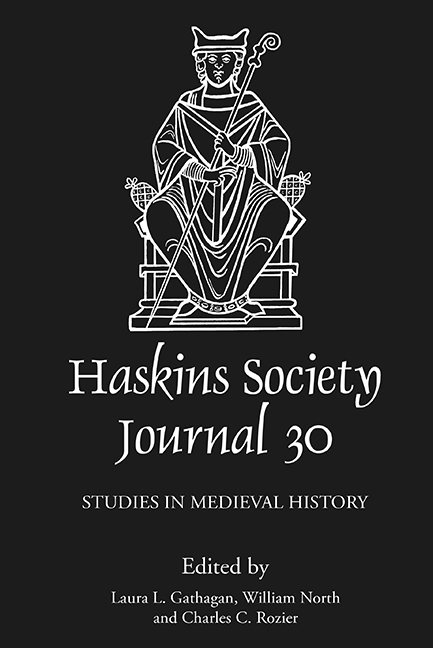Book contents
- Frontmatter
- Contents
- List of Figures and Tables
- Editor's Note
- Abbreviations
- 1 Beyond Corfe: Ælfthryth's Roles as Queen, Villain, and Former Sister-in-law
- 2 Medieval Curses and Their Users
- 3 ‘Although He Was His Nephew’: A Study of Younger Hautevilles Either Side of the Sea
- 4 Nearly Gold and Nearly Perfect? Copper, Meaning, and Materiality in Norman Sicily
- 5 Bound by Loyalty: Conflict, Communication and Group Solidarity in Early Twelfth-Century Southern Italy
- 6 Hugh of Lincoln and Adam of Eynsham: Angevin Kingship Reconsidered
- 7 Earthly Kings, Heavenly Jerusalem: Ralph Niger's Political Exegesis and the Third Crusade
- 8 ‘Holy Christendom's New Colony’: The Extraction of Sacred Matter and the Colonial Status of the Latin Kingdom of Jerusalem
- 9 Medieval French Peasants: The New Frontier?
4 - Nearly Gold and Nearly Perfect? Copper, Meaning, and Materiality in Norman Sicily
Published online by Cambridge University Press: 30 April 2020
- Frontmatter
- Contents
- List of Figures and Tables
- Editor's Note
- Abbreviations
- 1 Beyond Corfe: Ælfthryth's Roles as Queen, Villain, and Former Sister-in-law
- 2 Medieval Curses and Their Users
- 3 ‘Although He Was His Nephew’: A Study of Younger Hautevilles Either Side of the Sea
- 4 Nearly Gold and Nearly Perfect? Copper, Meaning, and Materiality in Norman Sicily
- 5 Bound by Loyalty: Conflict, Communication and Group Solidarity in Early Twelfth-Century Southern Italy
- 6 Hugh of Lincoln and Adam of Eynsham: Angevin Kingship Reconsidered
- 7 Earthly Kings, Heavenly Jerusalem: Ralph Niger's Political Exegesis and the Third Crusade
- 8 ‘Holy Christendom's New Colony’: The Extraction of Sacred Matter and the Colonial Status of the Latin Kingdom of Jerusalem
- 9 Medieval French Peasants: The New Frontier?
Summary
While two-dozen cathedrals with medieval copper-alloy doors remain in Europe, the Duomo at Monreale – the cathedral of Santa Maria Nuova (Figure 1) – is the only one in Sicily and the only one with two sets of doors, rather than just one (Figures 2 and 3). These doors lend an air of grandeur to what is now a relatively minor urban centre, an aspirational element that signifies the Mediterranean ambitions of the later Norman kings who controlled Sicily in the twelfth century. Over the course of the second half of the eleventh century the Normans established a kingdom that extended from the area around Naples in the southern Italian peninsula to Sicily, at times stretching even to North Africa, and lasted until almost 1200. It actively challenged and competed with major Mediterranean empires of the time, such as the Byzantines and the Fatimid Caliphs. As part of this effort, the Normans developed a visual and material vocabulary of power and wealth that avoided association with other Latin European groups by invoking cultural elements of the major eastern Mediterranean powers. Norman kings commissioned a range of objects in this uniquely Sicilian style, from palaces to garments to coins, but it is in objects such as monumental copper-alloy doors that this style most clearly encompasses the materials used in addition to the motifs. Starting in the early eleventh century, copper-alloy doors similar to those of the cathedral at Monreale proliferated throughout Latin Europe, conveying the power of the kings, bishops and abbots who commissioned them through their artistic ambition and their invocation of ancient themes. Thus, when the Norman king William II (r. 1166–89) commissioned the Monreale doors, he drew upon an existing trend but also incorporated distinctly Mediterranean elements that would communicate Norman sophistication to an audience that included Byzantine Greek and Muslim peoples as well as Latin Christians. While scholarly attention has rightly focused on the iconography of the doors, this essay will argue that, for their Mediterranean audiences, the doors’ copper itself played a critical role in the symbolic power of Monreale because of the material's complex connections with wealth, learning and technology.
- Type
- Chapter
- Information
- The Haskins Society Journal 302018. Studies in Medieval History, pp. 79 - 106Publisher: Boydell & BrewerPrint publication year: 2020

